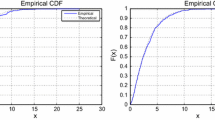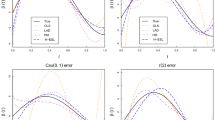Abstract
In this paper, we propose a flexible single-index partially functional linear regression model, which combines single-index model with functional linear regression model. All the unknown functions are estimated by B-spline approximation. Under some mild conditions, the convergence rates and asymptotic normality of the estimators are obtained. Finally, simulation studies and a real data analysis are conducted to investigate the performance of the proposed methodologies.
Similar content being viewed by others
References
Aneiros-Pérez G, Vieu P (2006) Semi-functional partial linear regression. Stat Probab Lett 76(11):1102–1110
Aneiros-Pérez G, Vieu P (2015) Partial linear modelling with multi-functional covariates. Comput Stat 30(3):1–25
Cai T, Hall P (2006) Prediction in functional linear regression. Ann Stat 34(5):2159–2179
Cardot H, Ferraty F, Sarda P (2003) Spline estimators for the functional linear model. Stat Sin 13(3):571–592
Carroll RJ, Fan J, Gijbels I, Wand MP (1997) Generalized partially linear single-index models. J Am Stat Assoc 92(438):477–489
Crambes C, Kneip A, Sarda P (2009) Smoothing splines estimators for functional linear regression. Ann Stat 37(1):35–72
Feng S, Xue L (2013) Variable selection for partially varying coefficient single-index model. J Appl Stat 40(12):2637–2652
Ferraty F, Vieu P (2006) Nonparametric functional data analysis: theory and practice. Springer, New York
Hall P, Horowitz JL (2007) Methodology and convergence rates for functional linear regression. Ann Stat 35(1):70–91
Huang J, Horowitz JL, Wei F (2010) Variable selection in nonparametric additive models. Ann Stat 38(4):2282–2313
Ichimura H (1993) Semiparametric least squares (SLS) and weighted SLS estimation of single-index models. J Econom 58(1):71–120
Lian H (2011) Functional partial linear model. J Nonparametr Stat 23(1):115–128
Peng Q, Zhou J, Tang N (2015) Varying coefficient partially functional linear regression models. Stat Pap 57(3):827–841
Schumaker LL (1981) Spline functions: basic theory. Wiley, New York
Shin H (2009) Partial functional linear regression. J Stat Plan Inference 139(10):3405–3418
Stoker TM (1986) Consistent estimation of scaled coefficients. Econometrica 54(6):1461–1481
Stone CJ (1982) Optimal rates of convergence for nonparametric estimators. Ann Stat 8(6):1348–1360
Stone CJ (1985) Additive regression and other nonparametric models. Ann Stat 13(2):689–705
Xia Y, Tong H, Li WK, Zhu L (2002) An adaptive estimation of dimension reduction space. J R Stat Soc Ser B (Stat Methodol) 64(3):363–410
Xue L, Zhu L (2005) Empirical likelihood confidence regions of the parameters in a partially linear single-index model. Sci China Ser A 48(10):1333–1348
Yao F, Müller HG, Wang JL (2005) Functional linear regression analysis for longitudinal data. Ann Stat 33(6):2873–2903
Yoshida T, Naito K (2014) Asymptotics for penalised splines in generalised additive models. J Nonparametr Stat 26(2):269–289
Yu P, Zhang Z, Du J (2016) A test of linearity in partial functional linear regression. Metrika 79(8):953–969
Yu Y, Ruppert D (2002) Penalized spline estimation for partially linear single-index models. J Am Stat Assoc 97(460):1042–1054
Yu Y, Ruppert D (2004) Root-n consistency of penalized spline estimator for partially linear single-index models under general Euclidean space. Stat Sin 14(2):449–456
Yuan M, Cai T (2010) A reproducing kernel Hilbert space approach to functional linear regression. Ann Stat 38(6):3412–3444
Zhao P, Xue L (2010) Variable selection for semiparametric varying coefficient partially linear errors-in-variables models. J Multivar Anal 101(8):1872–1883
Zhu H, Lv Z, Yu K, Deng C (2015) Robust variable selection in partially varying coefficient single-index model. J Korean Stat Soc 44(1):45–57
Zhou J, Chen M (2012) Spline estimators for semi-functional linear model. Stat Probab Lett 82(3):505–513
Acknowledgements
Yu and Zhang’s work is partly supported by the National Natural Science Foundation of China (No. 11771032, No. 11271039), Education Ministry Funds for Doctor Supervisors (No. 20131103110027) and Environment project (No. K2005790201601/002). Yu and Du’s research is supported by the National Natural Science Foundation of China (No. 11501018) and Program for Rixin Talents in Beijing University of Technology (No. 006000514116003).
Author information
Authors and Affiliations
Corresponding author
Appendix
Appendix
The following lemma, which follows easily from Corollary 6.21 of Schumaker (1981), is stated for easy reference.
Lemma 1
If \(g_0(u)\) and \(\beta _0(t)\) satisfy condition \(\text {C}3\), then there exists \(\varvec{\eta }_0\) and \(\varvec{\gamma }_0\) such that
where \({{\varvec{\eta }_0}=({\eta }_{01},\ldots ,{\eta }_{0N_1})}\), \({{\varvec{\gamma }_0}=({\gamma }_{01},\ldots ,{\gamma }_{0N_2})}\), and \(c_1>0\) and \(c_2>0\) depend only on \(l_1\) and \(l_2\), respectively.
Proof of Theorem 1
Let \(\delta =n^{-{\frac{r}{2r+1}}}\), \(\varvec{T}_1=\delta ^{-1} \big (\varvec{\phi }-\varvec{\phi }_0\big )\), \(\varvec{T}_2=\delta ^{-1}\big (\varvec{\eta }-\varvec{\eta }_0\big )\), \(\varvec{T}_3=\delta ^{-1}\big (\varvec{\gamma }-\varvec{\gamma }_0\big )\) and \(\varvec{T}=(\varvec{T}_1^\tau ,\varvec{T}_2^\tau ,\varvec{T}_3^\tau )^\tau \). We next show that, for any given \(\epsilon >0\), there exists a sufficient large constant \(L=L_\epsilon \) such that
This implies with the probability at least \(1-\epsilon \) that there exists a local minimizer in the ball \(\{\varvec{\theta }_0+\delta \varvec{T}:\Vert \varvec{T}\Vert \le L\}\).
Using Taylor expansion and a simple calculation, we can obtain
where \(R_{1i}=g_0(\varvec{Z_i}^\tau \varvec{\alpha }(\phi _0))-\varvec{B}_1\big (\varvec{Z_i}^\tau \varvec{\alpha }(\phi _0)\big )^\tau \varvec{\eta }_0\), \(R_{2i}=\big \langle X_i(t), \beta _0(t)-\varvec{B}_2(t)^\tau \varvec{\gamma }_0\big \rangle \), and \(U_i=\varvec{W}_i^\tau \varvec{T}_3+\varvec{B}_1\big (\varvec{Z_i}^\tau \varvec{\alpha }(\phi _0)\big )^\tau \varvec{T}_2+\varvec{B}'_1\big (\varvec{Z_i}^\tau \varvec{\alpha }(\phi _0)\big )^\tau \varvec{\eta }_0\varvec{T}_1^\tau \varvec{J}^\tau _{\phi _0}\varvec{Z}_i+\delta \varvec{B}'_1\big (\varvec{Z_i}^\tau \varvec{\alpha }(\phi _0)\big )^\tau \varvec{T}_3\varvec{T}_1^\tau \varvec{J}^\tau _{\phi _0}\varvec{Z}_i\). By condition C1, Lemmas 1 and 8 in Stone (1985), we can obtain that \(|R_{1i}|\le ck_1^{-r}\), \(|R_{2i}|=O_p(k_2^{-r})\), and
Then, invoking conditions C1, C4 and C5 and Eq. (A2), a simple calculation yields
Similarly, we can obtain \(\sum _{i=1}^{n}e_iU_i=O_p(\sqrt{n})\Vert \varvec{T}\Vert \), \(\sum _{i=1}^{n}R_{2i}U_i=O_p(nk^{-r})\Vert \varvec{T}\Vert \), \(\sum _{i=1}^{n}U_i^2=O_p(n)\Vert \varvec{T}\Vert ^2\). Thus, it is easy to show that \(\text {A}_1=O_p\big (n\delta ^2\big )\Vert \varvec{T}\Vert \), \(\text {A}_2=O_p\big (n\delta ^2\big )\Vert \varvec{T}\Vert ^2\), and the order of \(\text {A}_2\) is non-degenerate. By choosing a sufficiently large L, \(\text {A}_2\) dominates \(\text {A}_1\) uniformly in \(\Vert \varvec{T}\Vert =L\). Hence, Eq. (A1) holds, and there exists local minimizers \(\hat{\varvec{\phi }}\), \(\hat{\varvec{\eta }}\) and \(\hat{\varvec{\gamma }}\) such that \(\Vert \hat{\varvec{\phi }}-\varvec{\phi }_0\Vert =O_p(\delta )\), \(\Vert \hat{\varvec{\eta }}-\varvec{\eta }_0\Vert =O_p(\delta )\) and \(\Vert \hat{\varvec{\gamma }}-\varvec{\gamma }_0\Vert =O_p(\delta )\). By a simple calculation, we can get \(\Vert \hat{\varvec{\alpha }}-\varvec{\alpha }_0\Vert =O_p(\delta )\). Thus, we complete the proof of first part of (7).
Next we consider \(\Vert \hat{{\beta }}(\cdot )-\beta _0(\cdot )\Vert \). Let \(R_{2k_2}(t)=\beta _0(t)-\varvec{B}^\tau _2(t)\varvec{\gamma }_0\), we have
where \(\varvec{H}=\int _{0}^{1}\varvec{B}_2(t)\varvec{B}^\tau _2(t)dt\). Then, invoking \(\Vert \varvec{H}\Vert =O(1)\) (see, e.g., Feng and Xue 2013; Zhu et al. 2015) and \(\Vert \varvec{\gamma }-\varvec{\hat{\gamma }}_0\Vert =O_p(\delta )\), a simple calculation yields \((\hat{\varvec{\gamma }}-\varvec{\gamma }_0)^\tau \varvec{H}(\hat{\varvec{\gamma }}-\varvec{\gamma }_0)=O_p(\delta ^2)\). In addition, it is easy to show that \(\int _{0}^{1}(R_{2k_2}(t))^2dt=O_p(\delta ^2)\). Then, we complete the proof of second part of (7). Using an argument similar to \(\hat{\beta }(t)\), we can obtain the third part of (7).\(\square \)
Proof of Theorem 2
For convenience sake, we denote \(D_i=g'_0\big (\varvec{Z_i}^\tau \varvec{\alpha ({\phi }_0)}\big )\varvec{J}^\tau _{{\phi }_0}\varvec{Z}_i\), \(\hat{g}\big (\varvec{Z_i}^\tau \varvec{\alpha (\hat{\phi })}\big )=\varvec{B}_1\big (\varvec{Z_i}^\tau \varvec{\alpha (\hat{\phi })}\big )^\tau \varvec{\hat{\eta }}\), \(\hat{g}'\big (\varvec{Z_i}^\tau \varvec{\alpha (\hat{\phi })}\big )=\varvec{B}'_1\big (\varvec{Z_i}^\tau \varvec{\alpha (\hat{\phi })}\big )^\tau \varvec{\hat{\eta }}\). According to Theorem 1, we know that, as \(n\rightarrow \infty \), with probability tending to 1, \(Q(\varvec{\theta })\) attains the minimal value at \(\varvec{\hat{\theta }}=(\hat{\varvec{\phi }}^\tau ,\hat{\varvec{\eta }}^\tau ,\hat{\varvec{\gamma }}^\tau )^\tau \). Then , we have
Furthermore, invoking condition C3, Lemma 1 and Eq. (A2), a simple calculation yields
Similarly, we have
where \(R_{2i}=\big \langle X_i(t), \beta _0(t)-\varvec{B}_2(t)^\tau \varvec{\gamma }_0\big \rangle \).
Let \(\Phi _n=\frac{1}{n}\sum _{i=1}^{n}\varvec{W}_i\varvec{W}^\tau _i\), \(\Psi _n=\frac{1}{n}\sum _{i=1}^{n}\varvec{W}_i[g_0(\varvec{Z}^\tau _i\beta (\phi _0))-\hat{g}(\varvec{Z}^\tau _i\beta (\hat{\phi }))]\), \(\Gamma _n=\frac{1}{n}\sum _{i=1}^{n}\varvec{W}_i\varvec{D}^\tau _i\), \(\Lambda _n=\frac{1}{n}\sum _{i=1}^{n}\varvec{W}_i(e_i+R_{2i})\). Then, by Eq. (A4), we have
Substituting Eqs. (A5) into (A3), we can obtain that
Note that
and
Let \(\widetilde{\varvec{D}}_i={\varvec{D}}_i-\varvec{\Gamma }_n^\tau \Phi _n^{-1}\varvec{W}_i\). By the law of large numbers and the definition of \(\Sigma _n\), we have
where \(\overset{p}{\longrightarrow }\) means the convergence in probability. Invoking Eqs. (A6)–(A9), it is easy to show that
Note that \(\frac{1}{\sqrt{n}}\sum _{i=1}^{n}\widetilde{\varvec{D}}_i\varvec{W}_i^\tau =0\), then, we have \(S_3=0\). Furthermore, a simple calculation yields
Using an argument similar to Theorem 3 in Zhao and Xue (2010), invoking
we can prove
Taking this together with condition C1, \(\sup _{u}\Vert \varvec{B}_2(u)\Vert =O(1)\) and \(|R_{2i}|=O_p(k^{-r})\), we can obtain \(S_{21}=o_p(1)\). Similarly, we can prove that \(S_{22}=o_p(1)\). Hence, we obtain that \(S_{2}=o_p(1)\). Thus, we have
Invoking Eq. (5), we can prove
Moreover, we have
The claim then follows from the central limiting theorem and Slutsky’s theorem.\(\square \)
Proof of Theorem 3
Following the same arguments used in Eqs. (A3) and (A4), by Theorems 1 and 2 and a simple calculation, we have
where \(\tilde{e}_i=e_i+R_{1i}+R_{2i}\), \(R_{1i}=g_0(\varvec{Z_i}^\tau \varvec{\alpha }(\varvec{\phi }_0))-\varvec{B}_1\big (\varvec{Z_i}^\tau \varvec{\alpha }(\varvec{\phi }_0)\big )^\tau \varvec{\eta }_0\) and \(R_{2i}=\big \langle X_i(t), \beta _0(t)-\varvec{B}_2(t)^\tau \varvec{\gamma }_0\big \rangle \). The remainder is \(o_p(1)\) because Theorem 2 and \(\big \Vert \varvec{B}_1\big (\varvec{Z_i}^\tau \varvec{\alpha (\hat{\phi })}\big )-\varvec{B}_1\big (\varvec{Z_i}^\tau \varvec{\alpha }(\varvec{\phi }_0)\big )\big \Vert =o_p(1)\). In addition, Eq. (A4) can be rewrite as
where the remainder is \(o_p(1)\) because \(\big \Vert \varvec{B}_1\big (\varvec{Z_i}^\tau \varvec{\alpha (\hat{\phi })}\big )-\varvec{B}_1\big (\varvec{Z_i}^\tau \varvec{\alpha }(\varvec{\phi }_0)\big )\big \Vert =o_p(1)\) and \(\Vert \varvec{W}_i\Vert =O_p(1)\). Invoking Eq. (A12), we have
Let
Substituting Eqs. (A14) into (A13), a simple calculation yields
Since that \(|R_{1i}| \le ck_1^{-r}\), \(|R_{2i}|=O_p(k_2^{-r})\) and \(\hat{\beta }(t)-\beta ^*(t)=\varvec{B}^\tau _2(t)(\hat{\varvec{\gamma }}-{\varvec{\gamma }}_0)\), for any fixed point \(t\in (0,1)\), as \(n\rightarrow \infty \), by the law of large numbers, the Slutsky’s theorem and the property of multivariate normal distribution, a simple calculation yields
where \( \Xi (t)=\lim _{n \rightarrow \infty }\frac{\sigma ^2}{k_2}\varvec{B}^\tau _2(t)\Delta _n\varvec{B}_2(t). \)
Next, the argument for index function \(g(\cdot )\) is the same. Since \(\hat{g}(u)-g^*(u)=\varvec{B}^\tau _1(u)(\hat{\varvec{\eta }}-{\varvec{\eta }}_0)\), for any fixed point \(u\in (a,b)\), as \(n\rightarrow \infty \), we have
where \(\Pi (u)=\lim _{n \rightarrow \infty }\frac{\sigma ^2}{k_1}\varvec{B}^\tau _1(u)\Lambda _n\varvec{B}_1(u).\) This completes the proof of Theorem 3.\(\square \)
Rights and permissions
About this article
Cite this article
Yu, P., Du, J. & Zhang, Z. Single-index partially functional linear regression model. Stat Papers 61, 1107–1123 (2020). https://doi.org/10.1007/s00362-018-0980-6
Received:
Revised:
Published:
Issue Date:
DOI: https://doi.org/10.1007/s00362-018-0980-6




